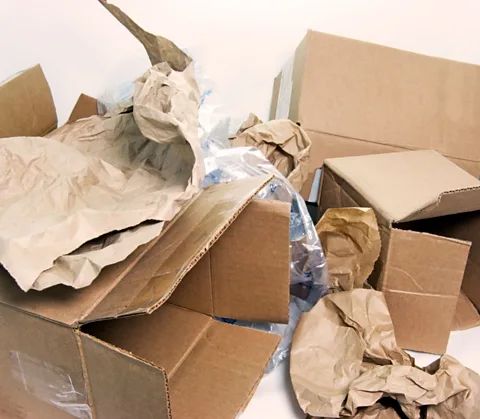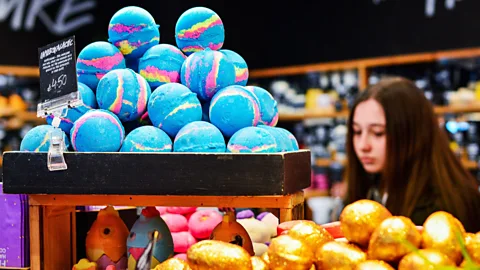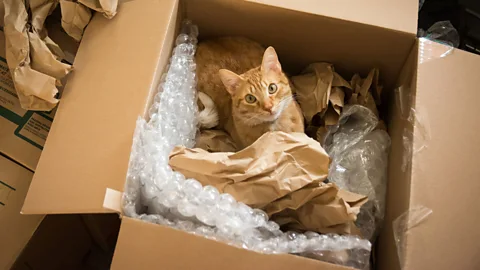Why your small goods come in gigantic boxes
 Getty Images
Getty ImagesEven the tiniest purchases often end up in massive packaging. It's not necessarily company carelessness – but it's still a big problem.
The saying goes, "good things come in small packages". But many online shoppers don't know that joy. If you order a comb the size of an envelope, there's a good chance it will arrive on your doorstep in a cardboard box that could fit a trombone.
This trend is more than just annoying – it's a sustainability nightmare. More than three billion trees are cut down every year to make the paper-based packaging that ends up cluttering your home or stuffed in a refuse bin, says Nicole Rycroft, executive director of Canopy, an environmental non-profit that works with companies to preserve endangered forests. Paper packaging production volumes have increased by 65% throughout the past two decades, according to the Food and Agriculture Organization of the United Nations (FAO).
The spike in online shopping is only making things worse. "In the early days of e-commerce, [products] had seven-times more packaging than with a brick-and-mortar purchase," says Rycroft. "It's now around four-and-a-half times as much, but still, that's a lot of excessive packaging."
Yet companies aren't simply being careless in the mismatch between product and container sizing, notes Barry Kronhaus, director of sales and marketing at Sun Packaging Technologies. "It's not quite as haphazard as it might seem, he says. "Places like Amazon and Walmart and their e-commerce fulfilment [centres] spend a lot of time trying to figure this out."
Yet the solution isn't so easy.
Packaging psychology
Typically, box size is determined by using software or an algorithm – and it often finds the correct match. But humans are still involved in getting orders order to customers, which is often how goods wind up in outsize containers.
For instance, a warehouse simply may not have enough of the right size of box, forcing a packer to pick the next best alternative, which is often bigger. "When you're relying on humans and they've got 100,000 orders to get out, they have to get it done fast," says Kronhaus. Especially when customers are paying the shipping charges, he adds, it doesn't hurt the company's bottom line to opt for the next size up.
 Getty Images
Getty ImagesIn some cases, consumers may actually place more value on products that come in larger containers. This is called "packaging psychology", says Rycroft, and some companies use it to their advantage – or at least don't go out of their way to ensure boxes are right sized for their contents.
An item that arrives in a large package makes the purchase seem like a good deal, according to Amsterbrand Marketing, a Dutch market research company. Buyers project human traits onto packaging that can also influence their purchasing decisions. For instance, a 2017 study on symbolic packaging clues found customers associated tall and thin food packages with health and slimness. Brands looking to target certain feelings may adapt their packaging accordingly.
Sustainability implications
Whatever the reason behind the mismatch, excessive packaging creates a substantial waste problem. The larger the packaging, the larger its carbon footprint – and the more ecological devastation it can cause.
While cardboard boxes from online orders are perhaps the most visible culprit, many industries use oversized packaging, primarily made from paper and plastic. Canopy estimates the food and beverage industry is the largest end-use sector for paper packaging, with beauty and personal care not far behind. And some brands in the fashion industry use as much fibre in their packaging as they do in their textiles and clothing, adds Rycloft.
Currently, 54% of the pulp used to make the paper packaging that becomes boxes and filling is made from recycled paper, according to data provided by Canopy, seen by the BBC. But 43% of that pulp is still made from virgin forest fibre – new wood that has been harvested for the first time. The organisation shared with the BBC that half of this virgin fibre could be coming from forests that are designated as "ancient and endangered". That leaves just 3% of pulp that's made from alternative forest-free eco-friendly fibres like wheat straw or bagasse.
This is a major issue as forest preservation has become integral in the fight against climate change. For the 76.3 million hectares (189.5 million acres) of primary forests in the tropics that have been lost throughout the past 20 years alone, approximately one-third of the world's total forests have been destroyed due to human activity. This includes logging for paper packaging – the demand drives about a tenth of this destruction, according to the FAO.
There are other culprits, too. When those large boxes show up, they are often filled with several plastic "air pillows" to pad the products inside and plastic packaging presents a similar environmental scourge. Plastic can take anywhere from 20 to 500 years to break down, according to the UN. Research in 2020 from ocean conservation organisation Oceana reported that Amazon alone generated 465 million pounds (211 kg) of plastic packaging waste in 2019. The number of air pillows they alone could "circle the Earth 500 times". An Amazon spokesperson disputed the report, telling Vox they used "about a quarter of the plastic packaging estimated by Oceana's report", and that it has reduced the weight of its outbound packaging by more than a third since 2015, eliminating nearly one million tons of packaging material.
Shipping 'naked'
To combat all the contributing detrimental effects on the environment, sustainability advocates are going directly to the retailers who are using these resource-intensive materials, both in shipping containers and in the product packaging itself.
 Alamy
AlamyCanopy, for instance, works with companies and retailers to ensure their packaging is not coming from a high carbon, high biodiversity value forest or generating any new virgin plastic. Instead, they advise companies to transition to using recyclable, compostable and NextGen materials, which use gene editing to create synthetic fibres. EcoEnclose, a US-based company that creates sustainable packaging and shipping supplies, offers products including recycled plastic wrap and display boxes with regenerative seaweed film as more thoughtful replacements.
Ideally, however, retailers should find ways to forgo excess packaging all together. Some e-commerce companies specifically are working towards this goal, both with minimising the volume and size of boxes they ship in as well as eliminating as much product packaging as possible.
At global retailer Lush, about half of the beauty brand's products can be taken home with no packaging. The company has carried these efforts over to e-commerce. "Starting in 2008, we decided to start shipping more products 'naked', to the point that currently, if products are not in a pot or bottle, they are consistently shipped naked in the box," says Ruth Andrade, environmental partner at Lush.
More like this:
Lush has also optimised box size to ensure there are appropriate options for the workers hand-packing the orders. This is part of widespread innovation throughout the past few years that Sun Packaging Technologies's Kronhaus says has enabled more accurate sizing in the packaging industry. Devices such as the dimensioning system Cubiscan scan the products needing to be boxed, and either instructs a machine to build a box that's the correct size for its contents, or determines what existing size box is best suited. According to Kronhaus, companies including Walmart and Amazon are now using this technology in certain facilities.
This technology doesn't just help with shipping. It also optimises storage within warehouses – another reason some companies are jumping on board. Kronhous says innovative packaging can reduce the amount of warehouse space needed by two thirds, which saves a company money. Another storage alternative is the reuse of materials, something Rycloft says saved one of Canopy's global retailer clients €14m ($15m; £12m). By reconstituting boxes used for warehouse deliveries, they were able to reuse the boxes on average six times, resulting in an 82% reduction in overall packaging. While these moves don't directly influence the size of packages that ultimately end up on doorsteps, they are an important part of improving sustainability across the entire supply chain.
 Getty Images
Getty ImagesNext steps
While significant strides have been made towards reducing packaging waste, there's still more work ahead. In November 2022, the European Commission introduced legislation to reduce packaging waste, including excessive box size. By March 2024, however, lobbyists had succeeded in making paper packaging largely exempt from this crackdown.
"The regulation now promotes single-use paper packaging, often lined with plastic, at the cost of global forests and the climate," Sergio Baffoni, a campaigner at the global Environmental Paper Network, said in a statement. "Industry lobbyists are celebrating, but consumers will continue to be hounded by increasing amounts of waste in their homes – there may be less plastic, but there will be far more paper – and far fewer forests."
Ultimately, no one aspect of the packaging waste problem can be solved without addressing the entire chain. The use of sustainable packaging materials relies on their accessibility, and the streamlining of packaging relies not just on precise calculations, but also effective delivery systems that don't necessitate excess packaging to keep items safe in transit.
"I think that's where our work really comes to the fore," says Rycroft. "Where the large corporate end consumer customers can create enough of a value proposition for the delivery entities to come to the table along with the packaging manufacturers." There, they can finally come up with a solution that's one size fits all.
--
For the best of BBC.com in your inbox every Friday, sign up to The Essential List newsletter for a handpicked selection of features, videos and can't-miss news.
